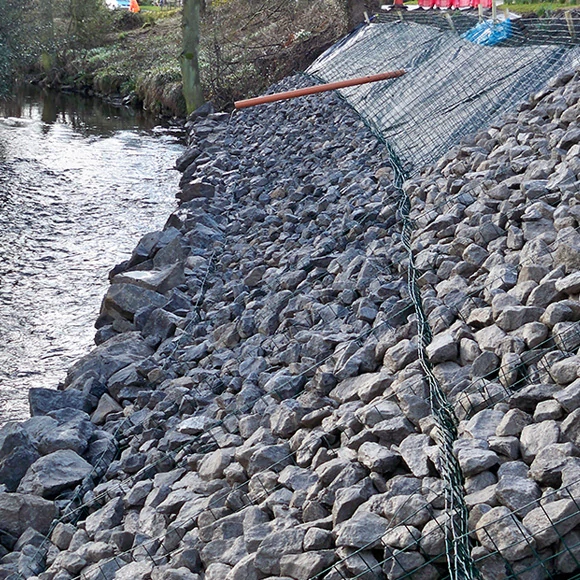Okt . 10, 2024 15:48 Back to list
gabion reno mattress
Exploring Gabion Reno Mattresses A Sustainable Solution for Erosion Control
In the realm of civil engineering and environmental management, gabion structures have gained significant attention as effective solutions for controlling erosion and enhancing landscape stability. Among these, gabion reno mattresses stand out due to their unique design and versatility. This article delves into the characteristics, advantages, applications, and the environmental sustainability of gabion reno mattresses.
What is a Gabion Reno Mattress?
A gabion reno mattress is a type of erosion control mattress made of wire mesh cages filled with stone or other granular materials. Unlike traditional gabions that are typically cube-shaped and used for retaining walls or other structural applications, reno mattresses are flatter, lower-profile structures designed to cover larger surface areas. The mattress design allows for flexibility in conforming to varying terrain and provides a more extensive footprint for effective water flow management.
The mesh used for gabion reno mattresses is typically heavier than standard gabions, ensuring durability and resilience against forces like water flow and sediment movement. This unique construction not only provides immediate erosion control but also promotes vegetation growth over time, further stabilizing the area.
Advantages of Gabion Reno Mattresses
1. Erosion Control Gabion reno mattresses are highly effective in controlling streambank, riverbank, and coastal erosion. By dissipating the energy of flowing water, these mattresses protect vulnerable areas from destructive erosion.
2. Cost-Effective Compared to traditional methods of erosion control, such as concrete or steel structures, gabion reno mattresses are more cost-effective in terms of materials and installation. The use of locally sourced stone can also reduce transportation costs.
3. Flexibility and Adaptability The design of gabion reno mattresses allows them to be custom-fitted to various landscapes and conditions. They can be used in conjunction with other erosion control measures, such as vegetation planting, to improve effectiveness and aesthetics.
4. Environmental Sustainability The porous nature of gabion reno mattresses promotes the infiltration of water through the structure, minimizing surface runoff and enhancing groundwater recharge. Additionally, over time, they can be colonized by vegetation, creating habitats for local wildlife.
gabion reno mattress

5. Ease of Installation The assemblage of gabion reno mattresses is straightforward, allowing for quicker installation compared to other erosion control solutions. This ease of use also makes them appealing to both professional engineers and community members looking to take an active role in their environment.
Applications of Gabion Reno Mattresses
Gabion reno mattresses have versatile applications across various sectors
- Riverbank Restoration They are particularly beneficial in restoring riverbanks and stabilizing areas where erosion is prevalent, helping to protect infrastructure and natural ecosystems.
- Coastal Protection In coastal areas, gabion reno mattresses can serve as barriers against storm surges, reducing the impact of waves on shorelines.
- Bridge Abutments They can also be used around bridge abutments to mitigate erosion and enhance the durability of the structure.
- Fire Control In fire-prone regions, these mattresses can help stabilize slopes and prevent mudslides, ensuring safer environments for communities.
- Landscaping and Aesthetics Beyond practical use, gabion reno mattresses can be styled creatively in landscaping projects, offering both functionality and an attractive natural appearance.
Conclusion
Gabion reno mattresses represent a forward-thinking solution for managing erosion, promoting environmental sustainability, and enhancing landscape stability. As society continues to grapple with environmental challenges, the importance of such innovative solutions cannot be overstated. By integrating technology, materials science, and ecological principles, gabion reno mattresses provide a robust answer to the pressures of erosion and landscape instability, all while fostering a healthier relationship between human development and the natural world.
-
The Role of Galvanized Gabion Mesh in Riverbank Protection
NewsJun.26,2025
-
The Role of Gabion Basket Raised Bed in Sustainable Gardening
NewsJun.26,2025
-
Quality Assurance of Wire Mesh Gabion Baskets
NewsJun.26,2025
-
Installation Guide for Welded Gabion Box
NewsJun.26,2025
-
How to Choose the Right Gabion Box
NewsJun.26,2025
-
Different Types of Gabion Wire Mesh
NewsJun.26,2025
-
Why PVC Coated Gabion Mattress Is the Best Solution for Long-Term Erosion Control
NewsMay.23,2025






